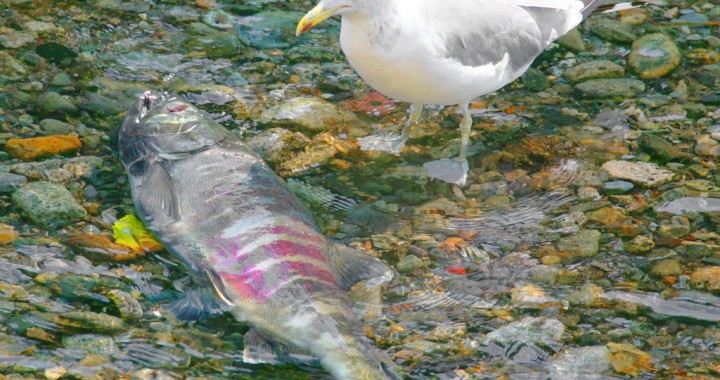As discussed in an early post, salmon play an extremely important role in supplying nutrients and energy to both freshwater and terrestrial ecosystems. The article “Pacific Salmon in Aquatic and Terrestrial Ecosystems” describes this role in more detail and discusses management and conservation considerations. Salmon runs provide a massive amount of biomass to inland streams. The article estimates that a large run of 20 million sockeye at Bristol Bay can yield 5.4 × 107 kilograms (kg) of biomass, which can be broken down into nitrogen, potassium, calcium, and other macroelements (Gende et. al., 2002). These elements are then distributed as the fish are consumed by predators or recycled into the ecosystem through decomposition. However, the ecological consequences of these nutrients vary according to ecosystems. In some systems, for example, there is already a high abundance of potassium from the bedrock while other streams depend on the potassium recycled annually by the salmon for productivity.
Other ecological considerations include the role that salmon play in population dynamics of both terrestrial and riparian consumers. Insect populations increase, which attracts birds and other consumers, affecting the composition of an ecosystem. Areas where salmon are available have been found to increase their carrying capacity to support bear populations that are 80% denser than areas without salmon (Gende et. al., 2002). Salmon also indirectly impact ecosystems; for example, the bears that feed on salmon also eat berries and other vegetation, spreading the seeds throughout their habitat. Nutrients from the salmon that is brought to land can fertilize plants and lead to enhanced growth, which then attracts herbivores to the area.
These impacts show that “the ecological importance of salmon subsidies to freshwater and terrestrial ecosystems forcefully emphasizes the importance of a broad, holistic perspective” (Gende et. al., 2002). Salmon provide valuable links between the ocean and land that need to be considered in management decisions. The response to salmon is also very species specific, which calls for ecosystem based management. For example, placing dead fish on a stream bank may help increase and move nutrients inland but it completely ignores the need for nutrients within the water itself. Conversely, pumping elements into the water artificially may mimic the nutrients from salmon but ignores the consumption component. In systems that are not already destroyed beyond repair, a common goal is to restore the salmon runs to naturally restore all of the ecosystem processes that they provide. The ecosystem services that salmon provide are so complex and impact so many different habitats that management can be a very complicated process. Complete restoration involves enhancing stream productivity and water quality, as well as returning areas to natural water flows and increasing access. Since these strategies are being considered for areas that have lost their salmon runs, it seems reasonable that we protect areas that still have viable salmon populations. Otherwise, in a few years we’ll find ourselves spending time and money trying to fix even more streams.
Image: http://en.wikipedia.org/wiki/File:Bald_Eagle_and_salmon.jpg
Featured Image: http://www.flickr.com/photos/jitze1942/4944589582/
Source: http://www.jstor.org/stable/10.1641/0006-3568%282002%29052%5B0917%3APSIAAT%5D2.0.CO%3B2


